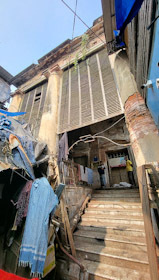A Parsi fire temple and a Russian in a street in Calcutta
ANYONE WHO KNOWS Calcutta well might wonder what made us stroll along Ezra Street. We had just left St Andrews Kirk (completed in 1818), where we heard the start of a Sunday service in Nepali, when I realised we were not far from Ezra Street. The Street is named after a trader David Joseph Ezra (died 1882) of Baghdadi Jewish heritage. But that is not why we visited the street.
My wife’s sister-in-law was brought up in number 48 Ezra Street in a house that my wife remembered as having been a glorious, picturesque old building. We wanted to see what, if anything, was left of the residence.
 The ruined agiari
The ruined agiariOn our way along the street, we spotted a board that read “Rustomjee Cowasjee Church”. We entered the building and saw nothing that looked remotely like a Parsi fire temple (agiari). Instead, we found ourselves in a series of dimly lit chandelier and fancy lamp showrooms. We asked about the “Parsi Church”, and were shown the way to it. By the way, it seems that if a place of worship is neither a ‘mandir’ nor a ‘masjid’, then it is described by locals in Calcutta as a ‘church’ – be it a church, a synagogue, or an agiari.
The agiari behind the lamp shops is no longer in use. It is falling to pieces and unsafe to enter. It stands behind a verandah whose roof is supported by sturdy pillars with Doric capitals. It must have been magnificent in its heyday. We saw two plaques – one in English, and the other in Gujarati. Although it is in a poor condition, Kolkata Heritage has listed it as a ‘Grade 1’ monument. It was built in about 1839.
Number 48 Ezra Street has been demolished and replaced by an unattractive new building. Outside its main entrance, there is a memorial plaque in English. It records that the Russian adventurer, linguist, musician, writer, and translator, Gerasim Stepanovich Lebedev (1749-1817), opened a theatre on the site of number 37 Ezra Street, which faces number 48. His theatre was the first in Calcutta to employ Bengali actors and actresses. The first performance was in November 1795.
According to Wikipedia:
“Lebedev lived in Calcutta (now Kolkata), then the capital of British India, for about ten years. During his stay, he started to learn Hindi, Sanskrit and Bengali from a local schoolteacher named Golokhnath Das. In exchange, Lebedev had to teach Das violin and European music. With the support of a Russian doctor, then practicing in Calcutta, he was soon established as a musician. Tickets for his musical programmes were priced at Rs. 12. Lebedev was the first person to use Indian tunes on Western musical instruments”
The British colonial authorities became unhappy with Lebedev being in India, and expelled him in 1797. Eventually, he returned to Russia, where he was employed by the Russian Foreign Ministry. But before reaching his native land, he stopped off in London, where he published his “Grammar of the Pure and Mixed East Indian Languages”.
Although we saw nothing of the house in which my wife’s sister-in-law lived during her childhood, our stroll along Ezra Street allowed us to discover the well hidden remains of a Parsi agiari as well as introducing us to the Russian indolgist, GS Lebedev.



